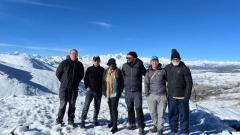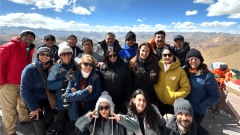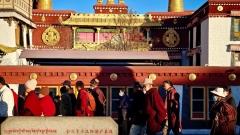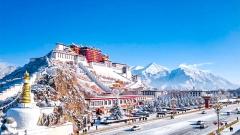When people think of Tibet, they often picture Lhasa, Everest Base Camp, or the holy lakes of Nagqu and Shigatse. Yet beyond the iconic attractions lies a world that few travelers ever reach—remote valleys sculpted by glaciers, turquoise lakes surrounded by snow peaks, and ancient kingdoms forgotten by time. Among these hidden treasures, Laigu Glacier, Ranwu Lake, and the Guge Kingdom ruins stand out as three of the most extraordinary but underrated places in Tibet. Together, they offer a blend of dramatic landscapes, natural history, and cultural mystery that rewards those willing to venture off the classic route.
Laigu Glacier: A Living Museum of Ice
Located in Bomê County in eastern Tibet, the Laigu Glacier (also spelled Laigu or Laigu Village Glacier Group) is one of the most beautiful and concentrated glacier clusters in China. It is often called a “living glacier museum” because it contains five major glaciers, including the famous Midui Glacier, which descends from snow peaks directly into a village—something extremely rare worldwide.
What Makes Laigu Glacier Special
-
Surprisingly accessible: Unlike high-altitude glaciers that require trekking, Laigu can be admired from viewpoints, lakesides, or short walking trails.
-
Blue ice in winter: From December to March, parts of the glacier reveal deep sapphire ice layers, perfect for photography.
-
A village shaped by glaciers: The nearby Laigu Village sits on ancient moraine deposits, giving it a surreal, otherworldly beauty.
-
Massive scale: Some glaciers stretch over 10 kilometers, forming towering fronts and intricate ice walls.
Laigu Glacier is one of the few places where you can truly observe the power, movement, and age of the Tibetan Plateau’s frozen world—without extreme trekking.

Laigu Glacier
Ranwu Lake: The Jewel of Eastern Tibet
Only a short drive from Laigu lies Ranwu Lake, often described as one of the most picturesque lakes in Tibet. Unlike the sacred alpine lakes of central Tibet, Ranwu stands out for its color variations, reflecting surrounding meadows, forests, and snow peaks.
Why Travelers Love Ranwu Lake
-
Unmatched color gradients: Depending on the season and sunlight, the water shifts from turquoise to jade green to deep blue.
-
Perfect reflections: Mornings often produce mirror-like views of glaciers and mountains, ideal for photographers.
-
Seasonal beauty:
-
Spring: Peach blossoms around nearby villages.
-
Summer: Green grasslands and wildflowers.
-
Autumn: Orange-yellow valleys with crystal-clear water.
-
Winter: Quiet, icy, and serene—often completely tourist-free.
-
-
Nearby hidden villages: Tibetan settlements around Ranwu offer warm homestays, authentic food, and insight into eastern Tibetan lifestyles.
Ranwu Lake is not just a scenic stop—it’s an atmosphere, a feeling of calmness framed by some of Tibet’s most dramatic landscapes.
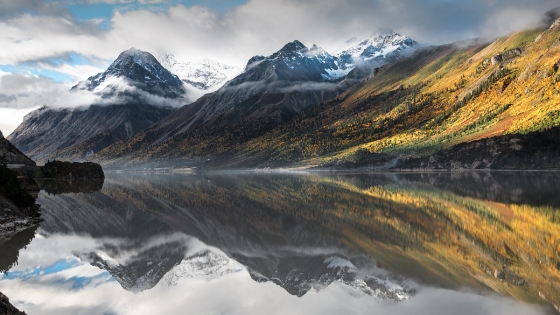
The Guge Kingdom: A Lost Civilization in the Desert
Far to the west, near Mount Kailash and Zanda County, lie the ruins of the Guge Kingdom, one of Tibet’s most mysterious ancient civilizations. With more than 1,000 years of history, Guge once served as a major center of Buddhism, art, and trade connecting Tibet, India, and Nepal.
Highlights of the Guge Kingdom Ruins
-
A fortress carved from earth: The entire site is built atop a hill of natural clay formations, giving it a maze-like appearance of tunnels, chambers, and lookout towers.
-
Murals and artistic treasures: Some temples still preserve delicate 11th–17th century wall paintings, showcasing Tibetan, Kashmiri, and Nepali artistic influences.
-
A civilization shrouded in mystery: The kingdom collapsed abruptly in the 17th century, leaving behind legends of wars, abandonment, and vanished royal families.
-
Endless desert landscapes: Surrounding Guge is the Tibetan Grand Canyon, a vast eroded terrain unlike anywhere else on the plateau.
The Guge ruins give travelers a rare chance to step into a vanished world—one where ancient Tibetan culture survived in isolation for centuries.

Guge Kingdom
Why These Places Are Underrated
Despite being breathtaking, these destinations remain lesser-known for several reasons:
-
Remote locations and long driving distances
-
Limited public transportation
-
Seasonal road conditions
-
Fewer tourism facilities compared to Lhasa or Shigatse
But for travelers seeking authentic, uncrowded, and dramatic Tibetan experiences, these are precisely the elements that make Laigu, Ranwu, and Guge so rewarding.
Best Time to Visit
-
Laigu Glacier: October–April for blue ice; May–October for lush scenery
-
Ranwu Lake: April–June & September–October for photography; winter for solitude
-
Guge Kingdom: May–October (winter roads may close)
How to Combine Them in One Trip
A common and stunning route is:
Lhasa → Nyingchi → Ranwu Lake → Laigu Glacier → Bomi → Shigatse → Western Tibet → Guge Kingdom → Mount Kailash → Lhasa
This creates a grand loop across eastern and western Tibet, combining forests, glaciers, lakes, deserts, and ancient ruins.
Final Thoughts
While many visitors focus on classic destinations, Tibet’s most underrated gems—Laigu Glacier, Ranwu Lake, and the Guge Kingdom—offer unmatched beauty, adventure, and cultural depth. Whether you love photography, history, or raw natural landscapes, these places remind you why Tibet remains one of the world’s most extraordinary travel regions.





